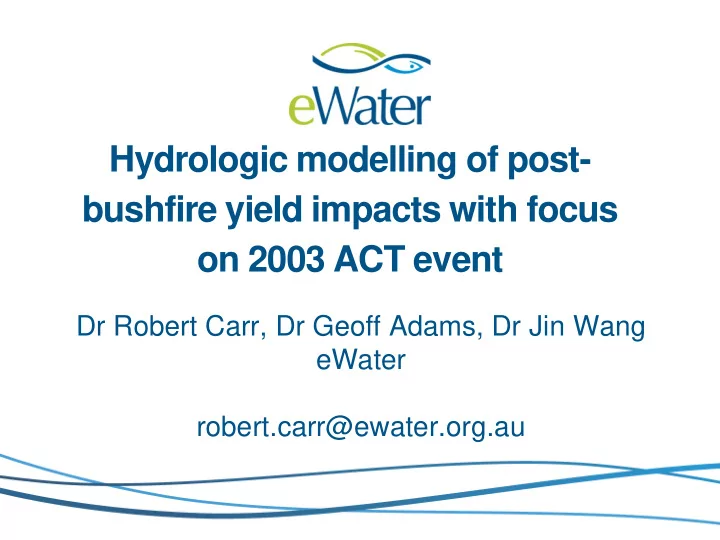

Hydrologic modelling of post- bushfire yield impacts with focus on 2003 ACT event Dr Robert Carr, Dr Geoff Adams, Dr Jin Wang eWater robert.carr@ewater.org.au
National Hydrological Modelling Strategy Agreements 2008+2018 • National Hydrological Modelling Strategy (NHMS), 2008 and Updated 2018 - Shared Integrated Platforms (Source+MUSIC) • National Collaboration Framework (2018) – 15-year NHMS Collaborative Head Agreement including IP Arrangements • 5 year 1+2+2 Source Project Agreement. Completed FY19 now contracted for FY20/21 for water sharing plan functionality. • Several ongoing additional contracts for new functionality Natural Resources, Mines and Energy
Short list of Models Applied in Australia to Assess Bushfire Yield Response • https://ewater.org.au/casestudies/Bushfire-Hydrology/ • MIKE-SHE – (DHI, 2004) ACT Bushfire analysis and projections - distributed model varying LAI and Root Depth a la Mountain Ash - high data requirements. • Macaque (Watson et al, 1999) & (Feikema et al. 2011, 2013) – Detailed distributed model applied to mainly Melbourne Water’s catchments - high data requirements • RAFIS (KS Tan et al, 2015) and Hydrofire (Wand et al, 2016) assessment tools applied to Melbourne and Victorian Catchments.
Ash and Mixed Eucalypt behave differently Mixed species eucalypts Ash species Photos provided by Professor Patrick Lane Forest Hydrology The University of Melbourne Mountain Ash dies, Mixed Eucalypt have far lower mortality rates. Therefore each catchment should be assessed individually for forest type, soils, burn severity etc.
Water Quality & Sediment Modelling • Melbourne catchments dominated by debris flows, requires unique risk assessment methods based on data. • ACT catchments dominated by gully and sheet erosion (GHD, 2003) • Adapted agricultural models (e.g. SEDNET, LASCAM, IHACRES etc) appropriately parameterized for post-bushfire gully and sheet erosion likely representative of ACT load generation processes. • ANU-led project on advanced WQ/Sediment algorithms for Source is ongoing. CLOE (Catchment constituent LOad Estimates) (Fu et al., in prep) , a new plugin for Source to be released • Issue of model structure/complexity to represent the underling hydrological processes
Comparison of SWAT and Source (GR4J) Nguyen et al. 2019 SWAT 33 Parameters vs GR4J 4 Parameters GR4J model structure too simple to reflect land use changes Need to find the right balance
LASCAM – LArge Scale CAtchment Model for streamflow, salinity, sediments and nutrients Developed by Viney and Sivapalan, 2000, adapted for eWater Source by Hall, 2011 • Developed initially for WA Catchments to bridge the gap between fully distributed and lumped conceptual models. • LASCAM ~28 parameters but could be reduced to ~20 and further with a research project. • Includes LAI and two-layer soil representation for root depth • Chosen for ACT because good for representing land use changes including urban and forest.
ACT Upper Murrumbidgee Multi-Purpose Source Model • LASCAM calibrated to 34 stream gauges 1980-2016 • 163 sub-catchments, 24 Land Use Categories • Water Quality constituents modelled – T otal Suspended Solids (TSS), T otal Phosphorus (TP), T otal Nitrogen (TN and Salinity.
Condor Creek at Threeways Cotter River at Gingera
Climate shift in flows adds complexity 2003 Bushfires Annual flows in the Cotter River at Gingera 2003 Bushfires 1994-2003 - catchments significantly drying Annual flows in Condor Creek at Threeways
Is there a bushfire signal? 1) Despite climate shift, a well calibrated and appropriately structured model should provide a consistent rainfall/evaporation to runoff transformation through low and high rainfall periods. The hypothesis is that variations may be due to bushfire impact. 2) Calibrate the LASCAM model to the entire recorded sequence (1980-2016) 3) Compare the model performance across range of time scales covering pre-bushfire, early post-bushfire and late post-bushfire. 4) Test for statistical reliability of predictions
Analysis - Condor Creek at Threeways Period 1980 - 2016 1980- 2003- 2008-2016 2002 2007 Early Pre- Late post- Overall post- bushfire bushfire bushfire Mean Annual Rainfall 1,018 1,054 818 1,036 (mm) Observed % 18.5% 20.7% 12.3% 15.2% Modelled% 18.9% 20.4% 9.5% 19.3% Response Anomaly -0.4% +0.4% +2.9% -4.0% Catchment is very disturbed with pine forests (formerly agriculture, compacted soils and significant post-bushfire remediation works) and areas of bare soil. So unlikely Mountain ash response. Statistically, the post-bushfire anomalies are 95% chance of being the same so most likely no significant response .
Analysis – Cotter River at Gingera Period 1980 - 2016 1980-2002 2003- 2008-2016 2007 Early Pre- Late post- Overall post- bushfire bushfire bushfire Mean Annual Rainfall 1,177 1,242 982 1,127 (mm) Observed % 22.5% 22.9% 16.4% 23.8% Modelled% 21.7% 24.0% 12.4% 19.5% Response Anomaly +0.8% -1.1% +4.1% +4.3% • Increase in flows post-bushfire persists – response consistent with drier unstructured soils, mixed Eucalypt with minimal disturbance. • Post-Bushfire response is 95% chance of being higher than pre-bushfire so likely slight increase in yield .
Conclusions (1) • Adoption of the Melbourne Ash catchment yield reduction curves does not appear to be appropriate for ACT catchments. • Mixed Eucalypt response is confirmed by the modelling and can be scaled to assess other areas of the ACT. Fire response for mixed species eucalypt forests, (Nolan et al.2014, 2015) Note: Axis is ET, not yield Graph provided by Professor Patrick Lane Forest Hydrology The University of Melbourne
Conclusions (2) • Two test catchments in bushfire-affected areas of ACT’s Cotter catchment show yield responses between ‘no impact’ and ‘slight increase’ which is consistent with mixed Eucalypt. • Appropriate Hydrological and Water Quality tools for Bushfire response with moderate data requirements can be developed within the present Source platform for adoption though the NHMS for other Governments and Agencies to benefit. • eWater Bushfire Hydrology community page will reflect this information and ongoing updates.
Thank You
Recommend
More recommend